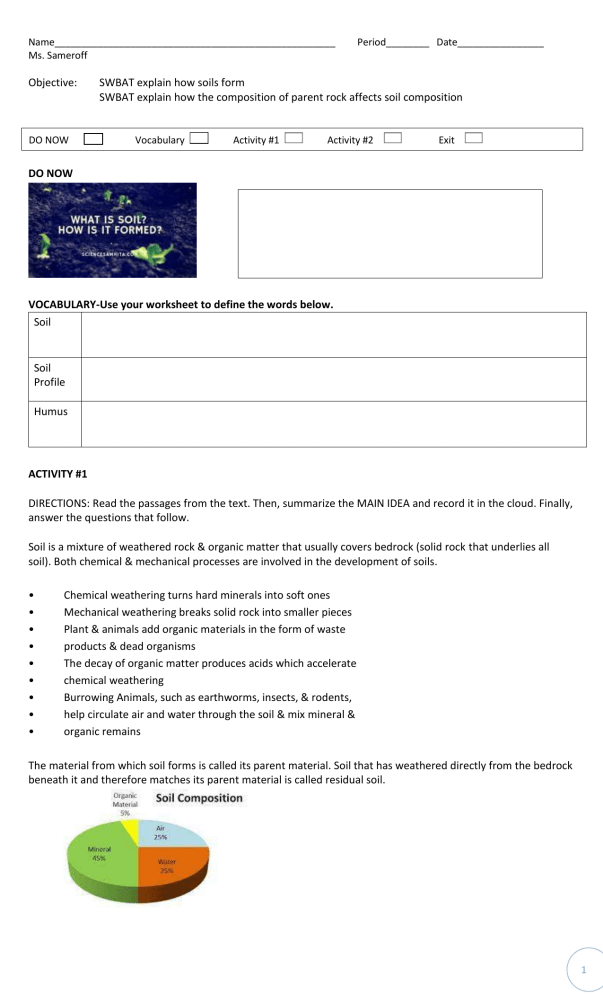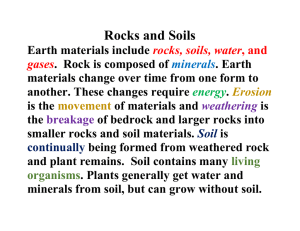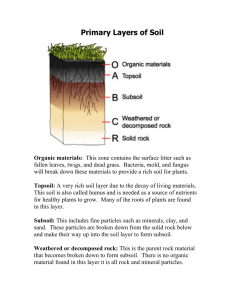
Name____________________________________________________ Ms. Sameroff Objective: DO NOW Period________ Date________________ SWBAT explain how soils form SWBAT explain how the composition of parent rock affects soil composition Vocabulary Activity #1 Activity #2 Exit DO NOW VOCABULARY-Use your worksheet to define the words below. Soil Soil Profile Humus ACTIVITY #1 DIRECTIONS: Read the passages from the text. Then, summarize the MAIN IDEA and record it in the cloud. Finally, answer the questions that follow. Soil is a mixture of weathered rock & organic matter that usually covers bedrock (solid rock that underlies all soil). Both chemical & mechanical processes are involved in the development of soils. • • • • • • • • • Chemical weathering turns hard minerals into soft ones Mechanical weathering breaks solid rock into smaller pieces Plant & animals add organic materials in the form of waste products & dead organisms The decay of organic matter produces acids which accelerate chemical weathering Burrowing Animals, such as earthworms, insects, & rodents, help circulate air and water through the soil & mix mineral & organic remains The material from which soil forms is called its parent material. Soil that has weathered directly from the bedrock beneath it and therefore matches its parent material is called residual soil. 1 Soil that does not match the bedrock it is over is called transported soil. It did not weather from the bedrock beneath it but was brought there by agents of erosion such as winds, rivers, or glaciers. Much of New England & the Midwest are covered by soil that was deposited by the movement of glaciers after the last Ice Age. A cross section of soil exposed by digging is called the soil profile. The weathering of soil produces layers known as soil horizons. The topsoil or A horizon is usually rich in dark-colored organic remains called humus (labeled O horizon below). The subsoil or B horizon contains minerals that have been transported deeper by groundwater. Most of the clay in soil has also been washed down to this layer. The partially weathered bedrock or C horizon is composed of broken up bedrock on top of the solid bedrock (parent material). Soil erosion is the removal of topsoil by the action of running water or wind. It takes between 100 & 400 years for one centimeter of topsoil to form. Loss of topsoil can be caused when plants root are no longer present to hold down soil. Salting roads can raise the salinity of the soil and kill the plants. Over grazing can kill plants. Winds construction & mining can all effect plant cover. Means of soil conservation include the following: Windbreaks – belts of trees along the edge of fields Contour farming – crops are planted in rows parallel to land contours Terraces- flattening hill slopes to slow the flow of water & erosion Strip Cropping – a crop that leaves bare ground between rows is alternated with a crop that completely covers the ground, ex. Corn & Alfalfa No-till method- plowing, planting and fertilizing are all done at the same time so there is less chance of wind removing topsoil QUESTIONS 1. What does chemical weathering do? _________________________________________________________________ 2. What does mechanical weathering do? _______________________________________________________________ 3. What is soil? (Use this sentence starter. Soil is…) ____________________________________________________________________________________________ ___________________________________________________________________________________________ 4. What do plants and animals add to the soil? ___________________________________________________________________________________ 5. How does decay of organic matter change the soil? ____________________________________________________________________________________________ ____________________________________________________________________________________________ 2 6. How do burrowing animals contribute to the soil? ____________________________________________________________________________________________ 7. What is the difference between: a. Parent material: ___________________________________________________________________________ b. Residual Soil: _____________________________________________________________________________ c. Transported Soil: __________________________________________________________________________ 8. How did much of the soil in the Midwest get there? ____________________________________________________________________________________________ ____________________________________________________________________________________________ 9. The layers of soil are called _________________________. 10. A horizon is also known as __________________________. 11. O horizon is also known as ___________________________. Which is what? ________________________________ 12. What is the problem with plants not being on the topsoil? ______________________________________________ 13. What five things affect/kill the plant cover that helps stop erosion? _______________________________________ _________________________________________________________________________________________________. 14. The cross-section of soil exposed by digging is called ____________________________________. 15. What two things cause soil erosion? __________________________________________. Label the soil profile diagram using the passage below. A cross section of soil exposed by digging is called the soil profile. The weathering of soil produces layers known as soil horizons. The topsoil or A horizon is usually rich in dark-colored organic remains called humus. It is located below the organic layer. The Organic layer is on the ground surface. The subsoil or B horizon contains minerals that have been transported deeper by groundwater. Most of the clay in soil has also been washed down to this layer. The partially weathered bedrock or C horizon is composed of broken up bedrock on top of the solid bedrock that is unweathered (R horizon). THINK, PAIR, SHARE Explain the process in the development of soils. _____________________________________________________________________________________________________ _____________________________________________________________________________________________________ _____________________________________________________________________________________________________ _____________________________________________________________________________________________________ _____________________________________________________________________________________________________ _____________________________________________________________________________________________________ ACTIVITY #2 Read the passage below and answer the questions that follow. Parent material affects soil fertility in many ways. First, the type of parent material determines which minerals (link to mineralogy) will predominate in the soil. Secondly, as parent material weathers, nutrients are released into soil solution, which subsequently can be taken up by plants and other organisms or leached from the soil. Parent material is the starting point for most soil development. The parent material may be mineral rock and/or organic matter. When parent rock material is exposed to the atmosphere or when organic matter and/or minerals are deposited on the earth’s surface, soil formation begins. The type of parent material and how the soil is formed will greatly influence the properties of the soil. There are two general rules that we may state about the influence of parent material on soil formation: 3 Finely textured parent materials tend to weather into finely textured soils. Coarsely textured parent materials tend to weather into coarsely textured soils. Darker minerals tend to yield more fertile soils. TYPE OF PARENT MATERIAL Parent Rock There are various types of parent rock material. The major two types of rocks on Earth are granite and basalt. While granite is prevalent on most of the continental United States, the primary parent rock material on Maui is basalt (Table 2). On Maui, basalt rock formed from the slow-moving lava flows of the East and West Maui shield volcanoes. Basalt rock is finely textured and comprised of small crystals which cooled rapidly along the surface of the earth. As a result, the soils which were weathered from basalt tend to be finely textured, as well as fertile when not highly weathered. In contrast to basalt, granite is coarse-textured rock that generally weathers into coarsely-textured soils. Granite is the parent material of most soils in the continental United States. Figure 9. A depiction of basalt rock. The primary parent rock material in Maui is basic igneous basic rock. Since basalt consists of small crystals, soils that weather from basalt tend to become finely-textured soils. Source: http://www.und.nodak.edu/instruct/mineral/natpark/haleak/photos/htm/21.htm Figure 10. Cliffs on Maui which consist of basalt rock columns. Source: http://www.hear.org/starr/hiplants/images/600max/html/starr_040514_0110_scaevola_sericea.htm Figure 11. Basalt rock outcrops in Maui pastures. Source: http://www.und.nodak.edu/instruct/mineral/natpark/haleak/photos/htm/20.htm Volcanic ash During the eruptions of Maui’s volcanoes, volcanic ash and other ejected materials, were deposited upon the volcanic slopes and adjacent areas. Volcanic ash has a non-crystalline, or amorphous, structure due to its rapid cooling. The soils that developed from volcanic ash contain mostly amorphous materials and minerals, such as allophane, imogolite, and ferrihydride. Coral Coral is a carbonaceous material that develops along coastal areas. In nutrient management, coral can serve as a valuable source of liming material to raise soil pH. Organic Matter In uplands of Maui, some soils have formed from the deposition and accumulation of plant residues, and other organic materials. Often these soils are called peat or muck. In Maui, organic soils are not widely used in agriculture. Organic soils of the world can be very important and productive agricultural soils. 4 TYPE OF FORMATION Residual parent material The soil develops in situ, or in place, as the parent material weathers. This is often the source of soil along mountain ridges. In the tropics, the soil formed tends to be highly leached and oxidic. Colluvial parent material The soil develops from rock fragments that fall from greater heights due to gravity. These soils tend to be coarse and stony. This mode of formation dominates along mountain slopes. Alluvial parent material The soil develops along a stream or river systems in floodplains, alluvial plains, or delta deposits. Soils have a great degree of particle sorting, as finer particles are kept in suspension by flowing water. Alluvial soils are common on Maui. Loess deposits The soil develops from deposits of particles by the wind. Particles are highly sorted because wind carries finer particles the furthest. Since volcanic ash is carried and deposited by wind, this method of formation is particularly important for volcanic ash soils. Categories of Parent Rock Material There are three categories of parent rock material. The first category is igneous rock. Igneous rock is cooled molten lava that originated from within the earth. There are two types of igneous rock: intrusive and extrusive igneous rock. Intrusive rocks are large crystals that have slowly cooled within the crust of the earth. An example is granite, which is used as a common building material. While this type of parent rock is common on the continental United States, it is not common in Hawaii. Instead, the most common parent rock material in Hawaii is extrusive igneous rock, which is often associated with volcanic activity. It is comprised of small crystals that cooled rapidly on the earth’s surface. An example of extrusive igneous rock is basalt. Now, let’s consider the two general rules of soil formation that were stated early. Since extrusive rock materials, such as basalt, are finely textured, the soils weathered from this parent rock tend to be finely-textured. And so, this is a reason why much of Hawaii soils are finelytextured. The next category of rock material is sedimentary rock. After long periods of compression, weathered products from older rocks will become cemented. As a result, another type of rock forms. Examples of this type are sandstone, shale, and limestone. The final category of parent rock is metamorphic rock. Metamorphic rocks have formed as the result of extreme heat or pressure. As a result, a change in the form of igneous or sedimentary rock occurs. For example, under extreme heat or pressure, igneous rocks will form schist gneiss, limestone will form marble, and shale will form slate. 1. How does parent material affect soil fertility? _____________________________________________________________________________________________________ _____________________________________________________________________________________________________ _____________________________________________________________________________________________________ 2. What are the two major types of rock on earth? (Use this sentence starter! The two major types of rock on earth are…) _____________________________________________________________________________________________________ _____________________________________________________________________________________________________ 3. How do metamorphic rocks form? ____________________________________________________________________________________________ ____________________________________________________________________________________________ ____________________________________________________________________________________________ EXIT TICKET After the lesson, now I understand… Something I still need help with… 5




